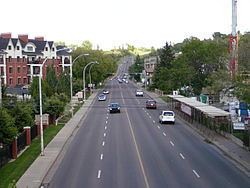Quadrant NW Sector Mature area Elevation 622 m | Ward 8 Area 19.28 km² Population 885 (2012) | |
 | ||
Restaurants Culina, Edmonton Queen Riverboat, Edmonton Queen Riverboat | ||
Cloverdale is a river valley neighbourhood in Edmonton, Alberta, Canada located on the south side of the North Saskatchewan River. It is located immediately across the river from the downtown core and the river valley neighbourhood of Riverdale. Southside neighbourhoods overlooking Cloverdale include: Bonnie Doon, Strathearn, Holyrood, and Forest Heights. The southwest corner of the neighbourhood is bounded by Connor's Road, the approaches to the Low Level Bridge, and the mouth of the Mill Creek Ravine. The Low Level Bridge and James McDonald Bridge connect the neighbourhood to the north side, while Scona Road provides access to Old Strathcona.
Contents
Map of Cloverdale, Edmonton, AB, Canada
The Muttart Conservatory—a botanical garden consisting of four glass, pyramid-shaped structures that showcase plants from arid, tropical, and temperate climates—is located in the Cloverdale neighbourhood.
Gallagher Park, where the Edmonton Folk Music Festival is held every August, is also located in Cloverdale. Cloverdale is also home to Edmonton's oldest ski hill, The Edmonton Ski Club.
Demographics
In the City of Edmonton's 2012 municipal census, Cloverdale had a population of 7002885000000000000♠885 living in 7002476000000000000♠476 dwellings, an 8.7% change from its 2009 population of 7002814000000000000♠814. With a land area of 19.28 km2 (7.44 sq mi), it had a population density of 7001459000000000000♠45.9 people/km2 in 2012.
Residential development
Early residential development in the area consisted of working-class homes for the men working at the numerous commercial and industrial sites in Gallagher Flats (as the area was then known) in the early 1900s. The population was such that when a new, two-classroom school was planned in 1912, it was expanded to four classrooms before being finished in 1913. Redevelopment of the neighbourhood since 1984 has seen the replacement of much of the early housing with much larger and more modern homes.
According to the 2001 federal census, one residence in five (18.4%) were constructed before 1946. Another one residence in five (20.4%) were built between 1946 and 1960. There was no further residential development in the neighbourhood until the late 1980s. Between 1986 and 1990, one in seven of the residences in modern Cloverdale were constructed. Almost half (46.9%) of residences were built after 1990.
Residential development has continued since the 2001 federal census. According to the 2001 census, there were 245 residences in the neighbourhood. By 2005, this had increased by 46%, with the 2005 municipal census reporting 358 residences.
The most common type of residence, according to the 2005 municipal census, is the single-family dwelling. These account for approximately half (47%) of all residences in the neighbourhood. One in three (36%) are apartment style condominiums in low-rise buildings with fewer than five stories. One in six residences (16%) are row houses. There is also one triplex in the neighbourhood. Almost six out of every seven (86%) of all residences are owner-occupied and one out of seven (14%) are rented.
